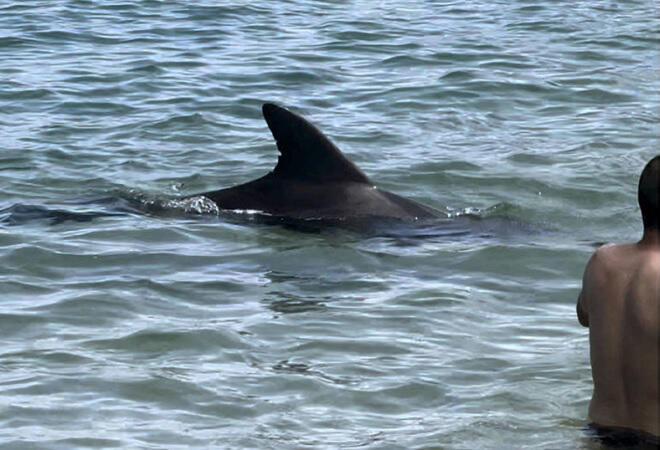Wild dolphin attacks at beaches in a central Japan prefecture have been on the rise since 2022, with experts suggesting that a sole Indo-Pacific bottlenose may be the culprit and that the aggressive behavior could escalate.
Eighteen people have been injured this summer at beaches in Fukui Prefecture as of Tuesday, including an elementary school student whose finger required 20 to 30 stitches and took a month to heal, according to the Tsuruga Coast Guard Office.
The number of incidents this year has increased rapidly compared to the last two, with at least one person injured in 2022 and five in 2023, according to the coast guard.

(Courtesy of a swimmer)
Provided by Kyodo News
On Tuesday, a man in his 50s suffered bite injuries on both hands from a dolphin while he was swimming off Mizushima island in Tsuruga, marking the second consecutive day an incident occurred at that beach.
Also on Aug. 13, a man in his 40s suffered minor injuries after suffering bites to his right thumb and left foot at Shiraki beach, also in Tsuruga.
Tadamichi Morisaka, a professor of cetology at Mie University, said that the dorsal fin characteristics of a dolphin spotted at the same beach a few days before the incident matched those of a 2.5-meter-long one observed off the coast of Fukui Prefecture up until last year.
"The dolphin may be coming to the beach in search of human interaction," Morisaka said.
While dolphins in aquariums are often seen forming bonds with humans, frequent interaction with people can cause them to try to assert their dominance through behaviors like biting and ramming, Morisaki said, adding that in such situations people should "move away from the dolphin immediately."
Ryoichi Matsubara, director of Echizen Matsushima Aquarium in Sakai, Fukui Prefecture, also warned that as some dolphins can be larger than bears, "contact with them can be very dangerous. It's too late once a fatal accident occurs."
Capturing dolphins is generally prohibited under government regulations and Fukui prefectural officials have said they currently have no plans to do so in this instance.
Some beaches have begun installing devices that emit ultrasonic waves as a deterrent, while swimmers are warned to leave the water immediately if they encounter a dolphin.




